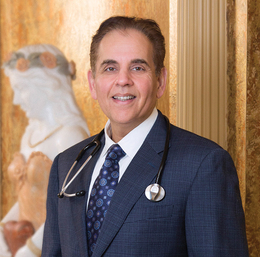
Dr. Vishal (Vic) Bahal, FACC, FASE, RPVI, a triple-board certified, non-invasive cardiologist, urges people who are potentially suffering from varicose veins (venous insufficiency) to confide in a trusted cardiovascular specialist for a diagnosis and a treatment plan. With 21 years of experience in all aspects of cardiovascular care, he is expanding his services to help people all over New Jersey.
Dr. Bahal spearheads Advanced Cardiology of South Jersey, which carries a trustworthiness and esteem befitting the certified Vein Center of Excellence’s higher standard of care, and recently spoke with Suburban Family to spread education and awareness about better vein health.
Q: What is venous insufficiency?
A: The veins take blood south to north, and if it goes south to north and leaks back, that's called vein reflux, also called vein insufficiency. Vein insufficiency is more common than heart disease, than stroke, atrial fibrillation, congestive heart failure and peripheral arterial disease. It's actually endemic in America right now. The reason it's so common is that doctors don't often ask questions to patients like: “How do your legs feel? Do your legs cramp up? Do they ache, do they swell, are they sore?” The signs of venous insufficiency would be leg cramping, heaviness, fatigue, aching, swelling, restless legs and itching, to name a few.
Q: Are there any factors that result in an increased risk for chronic vein disease?
A: The risk factors are as follows: obesity, anybody who's had pregnancies in the past, anybody who has a trauma to their legs, family history of vein disease or previous DVT [deep vein thrombosis]. Certain occupations predispose you to venous insufficiency, including people who stand on their feet a lot like retail clerks, teachers, lawyers, correction officers, or anybody who sits for prolonged periods of time with their legs down, such as secretaries and truck drivers. … If they have any cramping, tingling, numbness in the leg, you have to do what's called a venous reflux test, which is a 30-minute test we do all the time in our office.
Q: What does this test entail?
A: It’s a non-invasive test, we put cuffs on their legs and, through the aid of ultrasound, we can detect if it’s venous insufficiency. The patient is told to hydrate and to avoid caffeine prior to the test.
Q: What treatment is available, and what factors determine how you proceed?
A: If they have significant venous reflux, typically we will do conservative therapy with leg elevation, weight loss and compression stockings for ideally 90 days. If these conservative measures fail, we do a radiofrequency vein ablation, minimally invasive procedure. There is no downtime, there are no stitches, it takes about 20 minutes to do and it's done in my office in a sterile fashion often covered by insurance companies. The patient is free to go to work the same day or the following day.
There's no incision, no stitches, really no blood loss either—minimal to no blood loss. We basically go above the knee, we numb it up, and we put a little IV there; we call that a sheath. The radiofrequency catheter is floated into the bad refluxing vein. Then we take pictures and measurements, and then we numb up the vein and we deliver radiofrequency heat energy and we can seal the bad vein. Blood will then go through healthy veins, thereby alleviating all those symptoms mentioned.
Symptomatic relief is often seen within days to weeks or months; everyone is very individualized. At the end of the procedure, the catheter is removed, the sheath is removed, we put on a Band-Aid and we put on an ace bandage wrap for 48 hours. The patient returns after 48 hours to do a post-ablation ultrasound check and then the wrap is discarded. The patient often won’t need compression stockings anymore because the symptoms are totally gone. If they have it on the other leg, we wait about a week or two and then we do the other leg in the same fashion.
However, if you have vein reflux or vein insufficiency below the knees, we do what's called Varithena, which is a painless procedure that seals off the vein by using foam. Varithena is typically reserved for tortuous veins or for venous reflux that is below the knees. Varithena foam therapy takes about 10 to 15 minutes, is minimally invasive, no stitches, no incision, no downtime, [and it’s] often covered by insurers.
The procedure is about 99% successful, and it cures the problem. The veins rarely reopen—if they're done right the first time. The practice also offers cosmetic sclerotherapy which is quick and painless to get rid of unsightly spider veins. In this procedure a substance called polidocanol is injected to get rid of the spider veins.
Q: How soon after experiencing initial signs should a person see a doctor?
A: Once people have these symptoms—and this is under-diagnosed, under-tested and under-treated—they should contact the office right away. We do imaging five days a week, and we tell them to hydrate well before they come in, and don't take water pills if you're on any, don't have caffeine that morning because we want you hydrated. Then we do the half-hour venous insufficiency test in my office ... Therapy is tailored towards findings, and customized.
Advanced Cardiology of South Jersey
4 Burton Lane Suite 100, Mullica Hill, N.J.
(856) 241-3838
AdvancedCardiologySJ.com
Published (and copyrighted) in Suburban Family Magazine, Volume 14, Issue 4.
For more info on Suburban Family Magazine, click here.
For information about advertising in Suburban Family Magazine, click here.
To find out where to pick up your copy of Suburban Family Magazine, click here.




